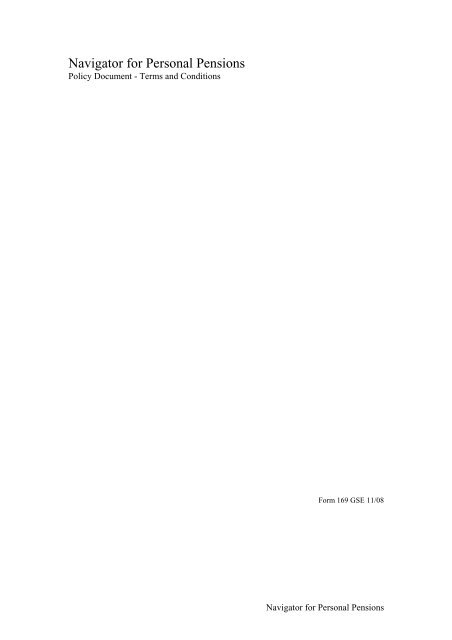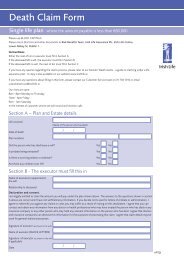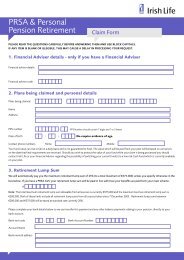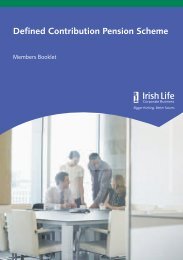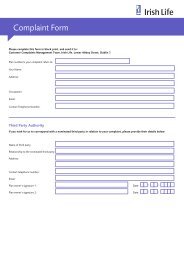Pension Performance Account for company pensions - Irish Life
Pension Performance Account for company pensions - Irish Life
Pension Performance Account for company pensions - Irish Life
You also want an ePaper? Increase the reach of your titles
YUMPU automatically turns print PDFs into web optimized ePapers that Google loves.
Navigator <strong>for</strong> Personal <strong>Pension</strong>s<br />
Policy Document - Terms and Conditions<br />
Form 169 GSE 11/08<br />
Navigator <strong>for</strong> Personal <strong>Pension</strong>s
Navigator <strong>for</strong> Personal <strong>Pension</strong>s<br />
Policy Document - Terms and Conditions<br />
These are your policy terms and conditions <strong>for</strong> your Navigator <strong>for</strong> Personal <strong>Pension</strong>s.<br />
Please keep them safe in your policy pack, as you will need them in the future.<br />
Navigator <strong>for</strong> Personal <strong>Pension</strong>s
What is a pension policy?<br />
A pension policy is a policy designed by <strong>Irish</strong> <strong>Life</strong> Assurance plc (we, us) to provide<br />
you with an income from your chosen retirement age. It may also provide life cover<br />
if you die be<strong>for</strong>e the chosen retirement age.<br />
You will find details of the policy in these terms and conditions, the member<br />
certificate, the application <strong>for</strong>m, and any extra conditions (endorsements) which we<br />
may add to it. Any conditions or extra rules we add in the future, if you agree, also<br />
<strong>for</strong>m part of the policy and may only be added by authorised staff at our chief office.<br />
Together they <strong>for</strong>m the terms and conditions of the policy.<br />
We have issued this policy to you on the understanding that the in<strong>for</strong>mation in the<br />
application <strong>for</strong>m and any related correspondence is true and complete and that we<br />
have been given all relevant in<strong>for</strong>mation. If this is not the case we will be entitled to<br />
declare the policy void. If this happens you will lose all your rights under the policy,<br />
any claim will not be paid and we will not refund any premiums. In<strong>for</strong>mation is<br />
relevant if it would influence the judgement of a reputable insurer when fixing the<br />
premium or the level of benefits, or in deciding whether to provide cover at all.<br />
We will pay benefits from our Head Office in Ireland, the <strong>Irish</strong> <strong>Life</strong> Centre, Lower<br />
Abbey Street, Dublin 1. All premiums and benefits under this plan will normally be<br />
paid in euro.<br />
In legal disputes <strong>Irish</strong> law will apply. The only terms or conditions that are legally<br />
binding are those specified in our contract with you.<br />
More detailed in<strong>for</strong>mation on all these matters is in the relevant sections of these<br />
terms and conditions.<br />
How does the policy work?<br />
You must pay the premiums in the amounts and on the dates described in the member<br />
certificate in return <strong>for</strong> the benefits described in the member certificate. We describe<br />
the benefits in greater detail later on in these terms and conditions.<br />
When will the benefits be paid?<br />
We will normally pay the benefits when you retire at the nominated retirement age.<br />
The nominated retirement age is shown in the member certificate. We must pay<br />
benefits to you if you die be<strong>for</strong>e this age.<br />
How are the benefits paid?<br />
We will pay you the benefits in the way you choose to receive them. However, this<br />
will be subject to conditions imposed by the Revenue Commissioners.<br />
Navigator <strong>for</strong> Personal <strong>Pension</strong>s
You, or your chosen dependants, are entitled to receive all of the benefits outlined in<br />
this policy except the death benefit. If you die, we will pay the death benefit to your<br />
executors or administrators.<br />
Writing to us<br />
If you need to write to us about this policy, please address your letter to:<br />
<strong>Irish</strong> <strong>Life</strong> Assurance plc.<br />
<strong>Irish</strong> <strong>Life</strong> Centre<br />
Lower Abbey Street<br />
Dublin 1<br />
Cooling-off period<br />
If, after taking out this policy, you feel that it is not suitable, you may cancel it by<br />
writing to us at the above address. If you do this within 30 days from the date we<br />
send you your policy (or a copy), we will cancel your policy. Your contribution, less<br />
any decrease in investment values over the period of the investment, will be repaid in<br />
line with Revenue rules. We strongly recommend that you contact your broker or<br />
financial adviser be<strong>for</strong>e you cancel your policy.<br />
Complaints<br />
We will do our best to sort out any complaint you may have. If you are not satisfied<br />
after complaining to us, you can take your complaint to the Financial Services<br />
Ombudsman. You can get more in<strong>for</strong>mation from:<br />
Financial Services Ombudsman’s Bureau<br />
3rd Floor<br />
Lincoln House<br />
Lincoln Place<br />
Dublin 2.<br />
Family law and <strong>pensions</strong><br />
If you are involved in a judicial separation or a divorce, a pension adjustment order<br />
may be granted by the Courts over the benefits payable from this policy on your<br />
retirement or death. Further in<strong>for</strong>mation on how pension adjustment orders work is<br />
available from the <strong>Pension</strong>s Board or your solicitor.<br />
Navigator <strong>for</strong> Personal <strong>Pension</strong>s
Contents<br />
Section 1<br />
Definitions<br />
This section defines some of the words and phrases we use in the terms and<br />
conditions.<br />
Section 2<br />
Premium Payments<br />
This section describes what your obligations are relating to paying premiums and<br />
explains what happens if payments fall behind.<br />
Section 3<br />
Benefits<br />
This section explains the benefits that we provide.<br />
Section 4<br />
Funds and Unit Prices<br />
This section explains how the investment funds work.<br />
Section 5<br />
Premiums and Charges<br />
This section describes the charges under the policy.<br />
Section 6<br />
Claims<br />
This section explains how you make a claim under the policy and how we will assess<br />
a claim.<br />
Section 7<br />
Tax<br />
This section deals with tax legislation and what will happen if there is any change in<br />
the law relating to tax.<br />
Section 8<br />
Law<br />
This section defines the law that will govern this policy.<br />
Navigator <strong>for</strong> Personal <strong>Pension</strong>s
Section 1<br />
Definitions<br />
This section defines some of the words and phrases we use in the terms and<br />
conditions.<br />
Certain words and phrases used in these terms and conditions have specific meanings,<br />
which might be different from the meaning they would have in general use. These<br />
words are shown in bold and listed below together with an explanation of their<br />
meanings in relation to this policy.<br />
Accumulated fund - the policy’s value at a point in time. We work this out as:<br />
the number of units allocated to the policy<br />
multiplied by<br />
the bid price of the units of the funds.<br />
We may use a market value adjuster with any part of the accumulated fund that is<br />
invested in the Secured <strong>Per<strong>for</strong>mance</strong> Fund or the Exempt Guaranteed Fund (see<br />
paragraphs 4.5 and 4.6).<br />
Annuity - a guaranteed payment made every month, <strong>for</strong> the month, until death.<br />
Application <strong>for</strong>m - the application <strong>for</strong>m <strong>for</strong> this policy. It includes any extra<br />
in<strong>for</strong>mation given to us about the policy or any other relevant in<strong>for</strong>mation.<br />
Approval - approval from the Revenue Commissioners.<br />
Approved Minimum Retirement Fund – a fund which is managed by a Qualifying<br />
Fund Manager and which complies with the conditions of Chapter 2 of Part 30 of the<br />
TCA <strong>for</strong> this type of fund.<br />
Approved Retirement Fund – a fund managed by a Qualifying Fund Manager and<br />
which complies with the conditions of Chapter 2 of Part 30 of the TCA <strong>for</strong> this type<br />
of fund.<br />
Bid price – the price of a unit of a fund, which we use to work out the value of the<br />
policy <strong>for</strong> each fund. This is the price we use when cancelling units from the policy.<br />
Consumer Price Index - the Consumer Price Index published by the <strong>Irish</strong><br />
government to measure inflation. (If this is not available, we will use an appropriate<br />
alternative.)<br />
Contribution cover - an optional policy benefit. If this benefit is chosen, premiums<br />
may be stopped <strong>for</strong> a period if you are disabled. We will place units into the unit<br />
account as though the regular premium was being paid. (See paragraphs 3.21 to 3.29)<br />
Navigator <strong>for</strong> Personal <strong>Pension</strong>s
Dependant - your spouse or child or any other person who depends on you<br />
financially immediately be<strong>for</strong>e your death. For this purpose a child includes a stepchild<br />
or legally adopted child.<br />
Disabled - when you suffer from an illness or injury which totally prevents you from<br />
carrying out your normal occupation and you are not following any other occupation.<br />
This inability must be confirmed by our Chief Medical Officer. The injury or sickness<br />
must have begun after the start date of the policy, or after the date contribution cover<br />
was added to the policy. The occupation refers to the occupation shown on the<br />
application <strong>for</strong>m or any other more recent job accepted by us.<br />
Endorsement - if the terms and conditions of the policy have been changed or are<br />
different to the standard terms, the new or amended terms or conditions will be set out<br />
in a separate document which will be attached to the policy. This is called an<br />
endorsement.<br />
Fund - any of the funds described in the panel of funds.<br />
Fund link - the fund or combination of funds in the panel of funds to which the<br />
policy is linked.<br />
Investment date – generally the date on which a premium is due. If premiums are<br />
paid on a date other than the date on which they are due, we reserve the right to invest<br />
the premium on the date it is paid. .<br />
Investment premium - the percentage of the premium that we invest <strong>for</strong> you as<br />
described in section 5.<br />
<strong>Life</strong> assured – the person on whose life the policy benefits depend. This is the person<br />
named in the member certificate.<br />
<strong>Life</strong> cover - the amount we will pay on your death, while the policy is in <strong>for</strong>ce.<br />
Market value adjuster - an adjustment to reduce the value of units of the Exempt<br />
Guaranteed Fund or the Secured <strong>Per<strong>for</strong>mance</strong> Fund in certain circumstances as set out<br />
in paragraphs 4.5 and 4.6.<br />
Member certificate - the member certificate that <strong>for</strong>ms part of this policy.<br />
Nominated retirement date – the date shown in the member certificate which is the<br />
date on which the accumulated fund will be available to buy retirement benefits in<br />
accordance with the terms of section 3.<br />
Offer price - the price which we use when allocating units to your unit account.<br />
Panel of Funds - the panel of funds includes the following funds and any other funds<br />
that we may add from time to time:<br />
Consensus Fund (Series 8)<br />
Navigator <strong>for</strong> Personal <strong>Pension</strong>s
Exempt Active Fund (Series 8)<br />
Exempt Cash Fund (Series 8)<br />
Exempt Guaranteed Fund (Series 8)<br />
Exempt Property Fund (Series 8)<br />
Fidelity Managed International Fund (Series 8)<br />
Gartmore Managed Fund (Series 8)<br />
Indexed Global Equity Fund (Series 8)<br />
<strong>Irish</strong> <strong>Life</strong> International MAPS Fund (Series 8)<br />
KBC Asset Managed Fund (Series 8)<br />
Secured <strong>Per<strong>for</strong>mance</strong> Fund (Series 8)<br />
For single premium contributions the following panel of funds applies and any other<br />
funds that we may add from time to time:<br />
Consensus Fund (Series 4)<br />
Exempt Active Fund (Series 4)<br />
Exempt Cash Fund (Series 4)<br />
Exempt Guaranteed Fund (Series 4)<br />
Exempt Property Fund (Series 4)<br />
Fidelity Managed International Fund (Series 4)<br />
Gartmore Managed Fund (Series 4)<br />
Indexed Global Equity Fund (Series 4)<br />
<strong>Irish</strong> <strong>Life</strong> International MAPS Fund (Series 4)<br />
KBC Asset Managed Fund (Series 4)<br />
Secured <strong>Per<strong>for</strong>mance</strong> Fund (Series 4)<br />
Premium due date - the date on which premiums should be paid to us. You will<br />
choose how often you pay premiums and this will be shown on the application <strong>for</strong>m.<br />
There will be no premium due date later than your 75th birthday or the date of your<br />
death.<br />
Qualifying Fund Manager – is defined in Chapter 2 of Part 30 of the TCA. <strong>Irish</strong><br />
<strong>Life</strong> is a qualifying fund manager.<br />
Regular premiums - any regular premium as shown in the member certificate or<br />
otherwise paid according to the terms of this policy. It includes any increases in<br />
regular premiums (see paragraph 2.4). It does not include any single premiums paid<br />
on a one-off basis.<br />
Retirement benefits – cash, annuity or other benefits provided by the accumulated<br />
fund.<br />
Single premium - a premium which is not a regular premium.<br />
Start date of the policy - is the date stated in the member certificate.<br />
Specified Income - means a pension or annuity which is payable <strong>for</strong> the life of<br />
the individual including a pension payable under the Social Welfare (Consolidation)<br />
Act 1993.<br />
Navigator <strong>for</strong> Personal <strong>Pension</strong>s
Suspension - where we have agreed that regular premiums can be stopped <strong>for</strong> a fixed<br />
period (see paragraph 2.7).<br />
TCA – the Taxes Consolidation Act 1997.<br />
Unit - each fund in the panel of funds contains a number of identical units that are<br />
called premium units. We will calculate the value of each premium unit by referring<br />
to the net value of the assets of the fund after deductions. We set aside a number of<br />
these units <strong>for</strong> the policy to calculate its value.<br />
Unit account – the number of units allocated to your policy in each fund.<br />
We, us, our - <strong>Irish</strong> <strong>Life</strong> Assurance plc.<br />
Your, you – the person named as the life assured in the member certificate.<br />
Navigator <strong>for</strong> Personal <strong>Pension</strong>s
Section 2<br />
Premiums<br />
This section describes your obligations to pay premiums and explains what happens if<br />
you fall behind with them.<br />
2.1 Premiums must be paid as described in the member certificate.<br />
2.2 We allow you 30 days to pay each premium unless the premium is paid in<br />
monthly instalments in which case this period is 10 days. If any premium is not<br />
paid within these periods, we will assume payments have stopped under the<br />
policy (see paragraph 2.8) unless the option to suspend premiums under<br />
paragraph 2.7 has been chosen.<br />
2.3 Each time a premium is paid we place units from one or more of the funds into<br />
the policy according to the terms of the latest fund link and in the way described<br />
in section 5. We use the unit offer price of each fund to work out the number of<br />
units from each fund, which we will place in the policy.<br />
2.4a Non-automatic increases in regular premiums<br />
You may write and ask to increase the regular premium giving at least one<br />
calendar month’s notice. Any increase must be at least as large as the minimum<br />
we allow.<br />
2.4b Automatic increases in benefits and premiums<br />
On each anniversary of the start date, we will increase the life cover ( if any )<br />
and regular premium by:<br />
• the rate of increase in the Consumer Price Index <strong>for</strong> the previous calendar<br />
year; or<br />
• any minimum rate we decide;<br />
whichever is greater.<br />
In making this assessment we will take account of other assurance benefit<br />
increases which apply in the insurance industry.<br />
At the time of printing (October 2008) the minimum increase we specify is 5%.<br />
This percentage is given as a guide only. The actual increase will depend on the<br />
circumstances at the time.<br />
The following also applies:<br />
• If you turn down any increase in life cover, we will not automatically give a<br />
further increase in life cover without seeking evidence of health.<br />
• We may use an index other than the Consumer Price Index to work out the<br />
rates that apply. We may also use a period other than one ending on an<br />
anniversary of the start date of the policy.<br />
Navigator <strong>for</strong> Personal <strong>Pension</strong>s
• If we do not receive the increased premium within the stated period (as<br />
defined in paragraph 2.2) we will assume you have turned down the<br />
increase in life cover or premium.<br />
• We have the right to restrict the normal amount of the automatic increase in<br />
the life cover, if the amount we must pay on your death under all policies<br />
would be more than our current assurance limit, which will not be less than<br />
€315,000.<br />
We do not need any evidence of health <strong>for</strong> increases under paragraph 2.4b.<br />
2.5 Reducing regular premiums<br />
You may write to us and ask us to reduce the regular premium by giving one<br />
month’s notice. This only applies if the policy has been in <strong>for</strong>ce <strong>for</strong> one year.<br />
The reduced regular premium must be at least as large as the minimum we<br />
allow.<br />
2.6 Option to pay single premiums<br />
You may pay single premiums to us depending on any fund restrictions that<br />
may exist at that time. There may be restrictions on investing in certain funds<br />
(see section 4). There may also be restrictions imposed by the Revenue<br />
Commissioners. The single premiums may not be less than the minimum<br />
amount we allow.<br />
2.7 Suspending regular premiums<br />
As long as the policy has been in <strong>for</strong>ce <strong>for</strong> one year, you can suspend the<br />
regular premiums.<br />
This option is available only if you give us written notice of the suspension<br />
period, at least one month be<strong>for</strong>e the next premium due date.<br />
If this option is used, the following will apply:<br />
• The policy will continue in <strong>for</strong>ce and any charges that apply be<strong>for</strong>e the<br />
suspension period will continue to apply <strong>for</strong> the suspension period. If the<br />
value of the accumulated fund falls to zero, the policy will end without a<br />
value and we will not pay any benefits.<br />
• If life cover benefit applies, this continues unless:<br />
(i) you request otherwise in writing; or<br />
(ii) during the suspension period the value of the accumulated fund falls to<br />
zero.<br />
If you want to reinstate the policy, the terms of paragraph 2.10 will apply.<br />
You must continue to pay the regular premium at the end of the suspension<br />
period. If this does not happen, the policy will become paid up (see paragraph<br />
2.9).<br />
Navigator <strong>for</strong> Personal <strong>Pension</strong>s
We will not provide contribution cover until six calendar months after regular<br />
premiums have started again.<br />
2.8 Discontinuing regular premiums<br />
• If regular premiums are unpaid without notice and a suspension has not been<br />
chosen and one full year has not passed since the start date, we will not pay<br />
any benefit. If you have paid a single premium, the policy will stay in <strong>for</strong>ce<br />
as a paid-up policy (see paragraph 2.9).<br />
• If premiums are unpaid without notice and a suspension has not been chosen<br />
but more than one full year’s regular premiums have been paid, the policy<br />
will stay in <strong>for</strong>ce as a paid-up policy from the date of the first unpaid<br />
premium.<br />
2.9 Paid-up policy<br />
A policy will become a paid-up policy in the following circumstances:<br />
• if regular premiums are unpaid without giving us notice and a suspension<br />
has not been chosen, as described in paragraph 2.8.<br />
• if you choose to have the policy changed to a paid-up policy. You can do<br />
this as long as at least one full year’s regular premiums have been paid.<br />
You can maintain the life cover or cancel the life cover (if this applies). If<br />
you cancel the life cover, the charge <strong>for</strong> life cover will stop, but the charge<br />
<strong>for</strong> the policy fee will continue.<br />
If a policy has become a paid-up policy:<br />
• The accumulated fund will remain invested in the fund(s) you have choosen<br />
until you decide to take retirement benefits, have attained age 75 or until<br />
you die.<br />
• <strong>Life</strong> cover will continue at the level which applied when the first unpaid<br />
premium became due (except if you have asked us to cancel it), as long as<br />
there is enough value in the accumulated fund to cover the cost of this<br />
benefit and other policy charges. Contribution cover benefits and charges<br />
cease when the policy is made paid-up. If the value of the accumulated fund<br />
falls to zero, the policy will end without value and we will not pay any<br />
benefit.<br />
• If you are eligible to receive retirement benefits immediately, we will use<br />
the accumulated fund to provide them. All benefits under the policy will<br />
end on that date and the policy will also end.<br />
• We will cash in all of the policy if you are transferring your fund to another<br />
Retirement Annuity Contract approved under Chapter 2, Part 30 of the TCA<br />
or a Personal Retirement Savings <strong>Account</strong> approved under Chapter 2A, Part<br />
30 of the TCA as described in paragraph 3.8. The amount we will pay to<br />
you will be the accumulated fund at the date we cash in units in the fund.<br />
On this date the policy will end.<br />
Navigator <strong>for</strong> Personal <strong>Pension</strong>s
2.10 Reinstating the policy<br />
If you have suspended regular premiums or discontinued them under paragraphs<br />
2.7, 2.8 or 2.9 and the policy has not been paid-up, you may ask us to reinstate<br />
the policy.<br />
We will ask <strong>for</strong> evidence of your health if contribution cover or life cover<br />
applies if these benefits have ended.<br />
We will reinstate the policy on the understanding that the in<strong>for</strong>mation given in<br />
the evidence of health <strong>for</strong>m and any related document is true and complete and<br />
that all relevant in<strong>for</strong>mation has been provided. If this is not the case we will be<br />
entitled to declare the policy void. If this happens you will lose all your rights<br />
to life cover under the policy, any claim will not be paid and we will not refund<br />
any premiums. In<strong>for</strong>mation is “relevant” if it might influence the judgement of<br />
a reputable insurer when fixing the premium or the level of benefits; when<br />
deciding whether to reinstate cover at all; or when deciding whether to attach<br />
conditions.<br />
We will also charge a fee to cover the administration cost of reinstating the<br />
policy. We may refuse to reinstate the policy if the evidence of health shows a<br />
change in the state of your health from that given on the application <strong>for</strong>m.<br />
Navigator <strong>for</strong> Personal <strong>Pension</strong>s
Section 3<br />
Benefits<br />
When is it possible to take retirement benefits?<br />
3.1 You can use your accumulated fund to provide retirement benefits at the earliest<br />
of the times set out below:<br />
(a) Your 75 th birthday or other nominated retirement date specified.<br />
(b) The first day of the month (between your 60 th and 75 th birthdays) after you<br />
tell us in writing that you wish to claim retirement benefits.<br />
(c) The first day of the month (be<strong>for</strong>e your 60 th birthday) after you give us<br />
evidence of your disability and you tell us in writing that you wish to claim<br />
retirement benefits due to serious ill-health. Revenue will allow you take<br />
your benefits be<strong>for</strong>e age 60, provided we receive medical evidence to show<br />
that you are in serious ill-health. The Revenue’s current definition of<br />
serious ill-health is that you are "permanently incapable, through infirmity<br />
of mind or body, of carrying on your own occupation or any occupation of a<br />
similar nature <strong>for</strong> which you are trained or fitted".<br />
(d) The first day of the month (between your 50 th and 60 th birthdays) after you<br />
give us evidence that your job is one in which people usually retire be<strong>for</strong>e<br />
their 60 th birthday and you tell us in writing that you wish to claim<br />
retirement benefits. You must have reached the age which has been<br />
approved by the Revenue Commissioners as defined in Chapter 2 of Part 30<br />
of the TCA.<br />
The accumulated fund will remain invested in the fund(s) you have choosen until you<br />
decide to take retirement benefits, have attained age 75 or until you die.<br />
What benefits are currently available?<br />
Tax-free lump sum<br />
3.2 You can take a lump sum of up to 25% of your accumulated fund as a cash<br />
amount tax-free. This is subject to limits <strong>for</strong> tax purposes, as described in<br />
section 7. The rest of your fund must be used to provide one or more of the<br />
other options described below. You do not have to take a tax-free lump sum.<br />
You could opt to use your full accumulated fund to provide one or more of the<br />
options described below.<br />
Annuity benefit<br />
3.3 You can choose to take an immediate single or joint life annuity option that we<br />
have available at the time you retire. Our annuity rates at the time you select<br />
the benefits will be used to calculate the amount of benefit that you will<br />
receive. The Revenue Commissioners may impose restrictions on the amount<br />
Navigator <strong>for</strong> Personal <strong>Pension</strong>s
of benefit that we may pay. Annuities would normally be paid monthly in<br />
advance.<br />
Some additional annuity features may also be available:<br />
(a) Your annuity may have a guarantee period of up to 10 years - this means<br />
that if you die during the guarantee period your annuity will continue to be<br />
paid to your dependants up to the end of the guarantee period.<br />
(b) You can choose a dependant’s annuity. This means that if you die be<strong>for</strong>e<br />
your dependant, we will pay your dependant a pension until he/she dies.<br />
We will pay this to someone you choose (other than your child) if we are<br />
satisfied that they depend on you. If this person is not your husband or<br />
wife, the maximum length of time <strong>for</strong> which we will pay the annuity must<br />
be approved by the Revenue Commissioners.<br />
(c) You can choose a children’s annuity <strong>for</strong> one or more children. This means<br />
if you die be<strong>for</strong>e your children, we will pay your children annuities until<br />
the child or children reach age 18 (or 21 if they are in full-time education),<br />
or until the child’s death if this is earlier.<br />
(d) For each type of annuity, you can choose <strong>for</strong> it to increase each year. The<br />
annuity can increase by the Consumer Price Index to take account of<br />
inflation or can increase by a fixed amount (<strong>for</strong> example 3% or 5% per<br />
annum) each year.<br />
Approved Minimum Retirement Fund<br />
3.4 If you do not take the annuity option described in 3.3 and you do not have a<br />
“specified income” of 12,700 each year <strong>for</strong> life at retirement, the lower of:<br />
(a) the balance of your accumulated fund (after you receive your tax-free<br />
lump sum cash payment, if you choose to take it), or<br />
(b) €63,500<br />
must be transferred to an Approved Minimum Retirement Fund (AMRF) or<br />
must be used to buy an annuity.<br />
You cannot encash your AMRF in full until you are 75. Until then, you are<br />
allowed to make partial withdrawals, but these are limited to the investment<br />
gains and income your AMRF fund has earned since the start of the policy.<br />
Under current Revenue rules, up until the age of 75, it is not possible to make<br />
any withdrawal if this withdrawal causes the fund value to fall below the<br />
original investment amount (and future transfers from another AMRF into<br />
your policy). After age 75, this restriction does not apply.<br />
You cannot normally make withdrawals from your AMRF be<strong>for</strong>e you reach<br />
age 75. The only exceptions to this are:<br />
(i)<br />
Income or profits from your AMRF may be withdrawn.<br />
Navigator <strong>for</strong> Personal <strong>Pension</strong>s
(ii) You may transfer the proceeds of your AMRF to another Qualifying<br />
Fund Manager.<br />
(iii) You may use the proceeds of your AMRF to purchase an annuity.<br />
Taxed Cash Lump Sum / Approved Retirement Fund<br />
3.5 After investing in an AMRF or annuity, or if you can show that you have a<br />
guaranteed income <strong>for</strong> life from other sources of €12,700 a year, the remainder<br />
(if any) of your accumulated fund can be used in either of the following ways:<br />
(a) It may be taken as a lump sum. This lump sum is subject to income tax <strong>for</strong><br />
the year of assessment in which you receive it.<br />
(b) It can be invested in an Approved Retirement Fund (ARF).<br />
Open Market Option<br />
3.6 You can also choose to purchase your annuity benefit from a life office other<br />
than us (<strong>Irish</strong> <strong>Life</strong>). The life office must be authorised to carry on life<br />
assurance business in the Republic of Ireland. If you decide to do this, we will<br />
pay your accumulated fund less any cash payment made to you to the other<br />
life office.<br />
It is also possible to invest in an ARF or AMRF that is run by another<br />
qualifying fund manager. If you decide to do this, we will pay your<br />
accumulated fund less any cash payment made to you to the other qualifying<br />
fund manager.<br />
Cashing in or assigning the benefit<br />
3.7 It is not possible <strong>for</strong> any of the benefits under this policy to be cashed in or<br />
assigned to anyone else.<br />
Transferring your policy to another Personal <strong>Pension</strong> Plan or a Personal<br />
Retirement Savings <strong>Account</strong><br />
3.8 You may transfer this policy to another Retirement Annuity Contract<br />
approved under Chapter 2, Part 30 of the TCA or a Personal Retirement<br />
Savings <strong>Account</strong> approved under Chapter 2A, Part 30 of the TCA. Our policy<br />
is capable of receiving a transfer value from another Retirement Annuity<br />
Contract which is in your name and approved by the Revenue Commissioners<br />
under Chapter 2, Part 30 of the TCA and such a transfer payment will be<br />
treated like a single premium.<br />
<strong>Life</strong> cover<br />
Paragraphs 3.9 to 3.20 will apply only if an amount of life cover is shown on the<br />
member certificate, schedule or any endorsement.<br />
Navigator <strong>for</strong> Personal <strong>Pension</strong>s
3.9 Under the policy we cover your life <strong>for</strong> the amount of life cover (if any) stated<br />
in the member certificate, schedule, or in any endorsement. If we have agreed<br />
to provide life cover under other terms and conditions these will also be stated<br />
in the member certificate, schedule or added to the policy by endorsement.<br />
3.10 We take the charge <strong>for</strong> life cover on the first day of each month from the date<br />
from which we agree to provide cover. We will work out this charge taking<br />
account of the following:<br />
a (i) The amount of life cover less the accumulated fund, if life cover is stated<br />
as inclusive on the member certificate or schedule; or<br />
(ii) The amount of life cover, if life cover is stated as exclusive on the<br />
member certificate or schedule.<br />
b Your age and sex.<br />
c Our rates relating to expected deaths on consideration of any medical or<br />
occupational in<strong>for</strong>mation, in<strong>for</strong>mation related to hobbies or pastimes and<br />
in<strong>for</strong>mation about your smoking habits. We may change these rates to<br />
reflect our actual experience.<br />
3.11 We will take the charge <strong>for</strong> life cover monthly by cancelling units from the unit<br />
account. We will cancel units from the funds in proportion to the latest fund<br />
split.<br />
3.12 If at any time the accumulated fund is less than the life cover charge due, the<br />
policy will end and all benefits will cease.<br />
3.13 You may write to us, asking to do the following:<br />
a Reduce the amount of life cover as long as the reduced amount is at least as<br />
great as the minimum we are prepared to accept.<br />
b Increase the amount of life cover as long as the increased amount is no<br />
greater than the maximum we are prepared to accept. If you ask <strong>for</strong> an<br />
increase you will have to provide proof of your state of health. If we accept<br />
this, the increased amount of life cover will apply from the first day of the<br />
following month. We may need to increase the premium to maintain the<br />
amount of life cover that you ask <strong>for</strong>.<br />
3.14 If you die within one year from the start date of the policy and you committed<br />
suicide or were executed by a penalty imposed by a court of law, we will not<br />
pay any life cover benefit over the value of the accumulated fund. If you die in<br />
this way within one year of the life cover being increased under paragraph 3.13<br />
(b) we will not pay the amount by which the life cover was increased.<br />
3.15 You must provide any in<strong>for</strong>mation and evidence we reasonably need to provide<br />
cover. We will act on this in<strong>for</strong>mation and evidence and will not be responsible<br />
<strong>for</strong> any error or mistake made by you or any person acting <strong>for</strong> you.<br />
Navigator <strong>for</strong> Personal <strong>Pension</strong>s
3.16 We will change the amount of life cover if we receive evidence of your date of<br />
birth and this is different to the date of birth given on the application <strong>for</strong>m.<br />
3.17 If the in<strong>for</strong>mation provided in the application <strong>for</strong>m and any related<br />
correspondence is not true and complete, or if relevant in<strong>for</strong>mation has not been<br />
revealed, we may reject or adjust the claim. In<strong>for</strong>mation is relevant if it might<br />
reasonably be expected to influence the judgement of an insurer when fixing the<br />
premium or the level of benefits, or in deciding whether to provide cover at all.<br />
3.18 When you die, we will pay any life cover to your estate according to the terms<br />
of the policy as long as the policy is still in <strong>for</strong>ce.<br />
a If the life cover shown on the member certificate or schedule is inclusive of<br />
the accumulated fund, the amount we will pay on your death will be the life<br />
cover or the accumulated fund on the date of death, whichever is higher.<br />
b If the life cover shown on the member certificate or schedule is exclusive of<br />
accumulated fund, the amount we will pay on your death will be the value of<br />
the accumulated fund on the date of death together with the life cover.<br />
c If no life cover is shown on the member certificate or schedule, we will pay<br />
the value of the accumulated fund on the date of death.<br />
We will pay any life cover according to the requirements of the Revenue<br />
Commissioners.<br />
The policy will end when you die and we pay out the benefits.<br />
3.19 <strong>Life</strong> cover (either inclusive or exclusive - see paragraph 3.18a and 3.18b) will<br />
end when all the accumulated fund has been used to provide retirement benefits,<br />
no later than the nominated retirement date.<br />
3.20 If you reduce the accumulated fund by taking retirement benefits and the life<br />
cover (if any) is inclusive of the accumulated fund, we will reduce the life cover<br />
by the same amount as the reduction in the accumulated fund.<br />
If the life cover is exclusive of the accumulated fund, the life cover will not<br />
change.<br />
Contribution cover<br />
3.21 Contribution cover will only apply if the regular premiums are being paid and<br />
‘Contribution Cover’ is shown as a benefit on the member certificate.<br />
3.22 If you become disabled and as long as regular premiums have not been stopped,<br />
we will continue to pay the regular premiums as described in paragraph 3.23.<br />
Navigator <strong>for</strong> Personal <strong>Pension</strong>s
3.23 The amount of regular premium which we will pay while you are claiming<br />
contribution cover will be the regular premium, paid over the 12 months leading<br />
up to the date from which we agree to pay the benefit. This does not include<br />
any regular premium increases in the 12 months be<strong>for</strong>e that date.<br />
We will pay this at the same frequency as the regular premium be<strong>for</strong>e the<br />
disability.<br />
3.24 We will not provide contribution cover benefit until we receive any in<strong>for</strong>mation<br />
and evidence we may reasonably need of your state of health. This may involve<br />
you having a medical examination by a medical officer we have appointed or<br />
approved. You must pay any related expenses.<br />
3.25 You must tell us immediately if you change occupation or move to a country<br />
outside the European Union. We may cancel contribution cover if we believe<br />
the change in your circumstances would increase our liability.<br />
3.26 We will only provide contribution cover <strong>for</strong> a disability which happens after the<br />
start date of the policy or the date at which the contribution cover was included<br />
in the policy, whichever is later.<br />
3.27 We will not pay contribution cover in the following circumstances:<br />
a For the first six calendar months of a period of disability, or be<strong>for</strong>e we<br />
receive written notice of the claim, whichever is later.<br />
b If the disability is caused by way of the following:<br />
• War, riot, revolution, or any similar event.<br />
• Taking part in a criminal activity.<br />
• Strike.<br />
• Self-inflicted injury or illness or taking alcohol or drugs (other than under<br />
the direction of a qualified medical practitioner).<br />
• Failing to follow reasonable medical advice.<br />
• Pregnancy or childbirth unless the disability goes beyond a period of three<br />
calendar months after the end of pregnancy or childbirth. In this case we<br />
will treat the disability as having started after the three calendar months.<br />
• In our opinion as a result of Acquired Immune Deficiency Syndrome<br />
(AIDS) or infection by any Human Immunodeficiency Virus (HIV).<br />
• As a result of taking part in abseiling, bobsleighing, boxing, hang gliding,<br />
scuba diving, horse racing, motor car and motor cycle racing or sports,<br />
mountaineering, parachuting, pot holing and caving, power-boat racing,<br />
rock climbing and flying other than as a fare-paying passenger on a<br />
regular public airline.<br />
3.28 We will stop paying contribution cover on the earliest of the following dates:<br />
a The date you recover and go back to your own occupation or the date we<br />
believe you are healthy enough to resume your own occupation.<br />
Navigator <strong>for</strong> Personal <strong>Pension</strong>s
The anniversary of the start date of the policy on or following your 60th<br />
birthday.<br />
c The date you die.<br />
d The date you move to a country outside the European Union. We may pay<br />
contribution cover again if you return and live in a country within the<br />
European Union. We must receive satisfactory evidence of your continued<br />
disability.<br />
e The date we start paying the retirement benefits under this policy.<br />
3.29 We will take the charge <strong>for</strong> contribution cover monthly, by cancelling units<br />
from the unit account. We will cancel units from the funds in proportion to the<br />
latest fund split.<br />
Navigator <strong>for</strong> Personal <strong>Pension</strong>s
Section 4<br />
Funds and unit prices<br />
This section explains how the investment funds work.<br />
4.1 Introduction<br />
This policy is unit-linked. Unit-linking is simply a way of working out the<br />
value of your policy on any date. You do not own the units. The policy will be<br />
linked to units in one or more of the funds in the panel of funds as defined in<br />
section 1. There are a maximum number of funds that the policy may be linked<br />
to at any one time. This maximum is currently (July 2008) five.<br />
The accumulated fund will remain invested in the fund you have choosen until<br />
you decide to take retirement benefits, reach your nominated retirement age or<br />
until you die.<br />
4.2 Working out unit prices<br />
We work out the offer ( buying ) and bid ( selling ) price of units in all of the<br />
funds by using the market value of the assets of the fund and taking off the<br />
management charge. These may go down as well as up. The bid price cannot be<br />
lower than 95% of the offer price. We place units in funds at the offer price.<br />
We cancel them at the bid price. The 5% difference between the offer and bid<br />
prices is a charge.<br />
The Exempt Guaranteed Fund and the Secured <strong>Per<strong>for</strong>mance</strong> Fund guarantee<br />
that the prices of the units of the fund will never fall. There are restrictions<br />
placed on units in the Secured <strong>Per<strong>for</strong>mance</strong> Fund and the Exempt Guaranteed<br />
Fund. There are circumstances where this price guarantee will not apply.<br />
We describe these funds in more detail later on.<br />
You will find exact details of how we calculate fund prices in the resolutions<br />
and rules governing the funds. You can ask us <strong>for</strong> a copy of these from our<br />
chief office.<br />
4.3 Fund charges<br />
Regular Premium Fund Charges<br />
We make certain charges on the regular premium funds and our current charges<br />
are summarised <strong>for</strong> each fund in the following table.<br />
Panel of funds<br />
Fund management<br />
charge each year<br />
Consensus Fund 1.65%<br />
Exempt Active Fund 1.75%<br />
Exempt Cash Fund 1.75%<br />
Exempt Guaranteed Fund 2.00%<br />
Exempt Property Fund 1.75%<br />
Navigator <strong>for</strong> Personal <strong>Pension</strong>s
Fidelity Managed International Fund 2.25%<br />
Gartmore Managed Fund 2.30%<br />
Indexed Global Equity Fund 1.65%<br />
<strong>Irish</strong> <strong>Life</strong> International MAPS Fund 2.00%<br />
KBC Asset Managed Fund 2.16%<br />
Secured <strong>Per<strong>for</strong>mance</strong> Fund 2.00%<br />
Single Premium Fund Charges<br />
We make certain charges on the single premium funds and our current charges<br />
are summarised <strong>for</strong> each fund in the following table.<br />
Panel of funds<br />
Fund management<br />
charge each year<br />
Consensus Fund 0.90%<br />
Exempt Active Fund 1.00%<br />
Exempt Cash Fund 1.00%<br />
Exempt Guaranteed Fund 1.25%<br />
Exempt Property Fund 1.00%<br />
Fidelity Managed International Fund 1.50%<br />
Gartmore Managed Fund 1.55%<br />
Indexed Global Equity Fund 0.90%<br />
<strong>Irish</strong> <strong>Life</strong> International MAPS Fund 1.25%<br />
KBC Asset Managed Fund 1.41%<br />
Notes to tables<br />
i We work out the fund management charge based on the offer price of the<br />
fund.<br />
ii We can only increase the fund management charge rate on any fund in the<br />
panel of funds if our board of directors passes a resolution. We would need<br />
to increase the fund management charge if the cost of administering the<br />
policies linked to the funds rose higher than expected. The operation of<br />
these Funds is described<br />
4.4 Fund prices<br />
The prices of units in all funds, with the exception of the Secured <strong>Per<strong>for</strong>mance</strong><br />
Fund, the Exempt Guaranteed Fund and the Exempt Cash Fund, will go up and<br />
down as the market value of the fund’s assets change.<br />
4.5 The Exempt Guaranteed Fund<br />
Working out the unit price<br />
The bid price of units in the Exempt Guaranteed Fund cannot fall. The growth<br />
each calendar year is also guaranteed to equal at least a minimum rate we<br />
declare in advance each year. We work out this minimum by taking account of<br />
the value of the assets of the Exempt Guaranteed Fund, the bid price of all the<br />
units of the fund and the expected future return on these assets.<br />
Navigator <strong>for</strong> Personal <strong>Pension</strong>s
Using the market value adjuster<br />
We may change the value of units of the Exempt Guaranteed Fund if you<br />
choose to switch your investment out of the Exempt Guaranteed Fund.<br />
We then work out the value of the units in the Exempt Guaranteed Fund as<br />
follows:<br />
the number of units in the Exempt Guaranteed Fund<br />
multiplied by<br />
the bid price of units in the Exempt Guaranteed Fund<br />
multiplied by<br />
the market value adjuster.<br />
The market value adjuster will be no higher than one. We use this to adjust the<br />
fund value to reflect any shortfall between the value of the assets in the fund<br />
and the bid price of all the units in the fund.<br />
We will not use the market value adjuster <strong>for</strong> units of the Exempt Guaranteed<br />
Fund if you retire on the nominated retirement date or you cash in the units to<br />
pay costs such as life cover charges, or on death.<br />
4.6 The Secured <strong>Per<strong>for</strong>mance</strong> Fund<br />
Working out the unit price<br />
The bid price of units in the Secured <strong>Per<strong>for</strong>mance</strong> Fund cannot fall. Also, the<br />
bid price is guaranteed to increase uni<strong>for</strong>mly throughout the calendar year at a<br />
rate we declare at the beginning of each calendar year.<br />
We will calculate the rate of increase we declare by taking account of the value<br />
of the assets of the Secured <strong>Per<strong>for</strong>mance</strong> Fund, the bid price of all the units in<br />
the fund and the expected future return on these assets.<br />
Using the market value adjuster<br />
We will change the value of units of the Secured <strong>Per<strong>for</strong>mance</strong> Fund if:<br />
a you choose to take retirement benefits within ten years of entering the<br />
Secured <strong>Per<strong>for</strong>mance</strong> Fund; or<br />
b you choose to switch the investment out of the Secured <strong>Per<strong>for</strong>mance</strong> Fund<br />
into another of the funds.<br />
c you choose to transfer your accumulated fund to another Retirement Annuity<br />
Contract approved under Chapter 2, Part 30 of the TCA or a Personal<br />
Retirement Savings <strong>Account</strong> approved under Chapter 2A, Part 30 of the TCA<br />
be<strong>for</strong>e your nominated retirement date as outlined in paragraph 3.8 above.<br />
Navigator <strong>for</strong> Personal <strong>Pension</strong>s
We then calculate the value of the units in the Secured <strong>Per<strong>for</strong>mance</strong> Fund as<br />
follows:<br />
the number of units in the Secured <strong>Per<strong>for</strong>mance</strong> Fund<br />
multiplied by<br />
the bid price of units in the Secured <strong>Per<strong>for</strong>mance</strong> Fund<br />
multiplied by<br />
the market value adjuster.<br />
The market value adjuster will be no higher than one. We use this to adjust the<br />
fund value to reflect any shortfall between the value of the assets in the fund<br />
and the bid price of all the units in the fund.<br />
We will not use the market value adjuster <strong>for</strong> units of the Secured <strong>Per<strong>for</strong>mance</strong><br />
Fund if you retire after regular premiums have been invested <strong>for</strong> at least ten<br />
years, you are retiring due to serious ill-health, you die or cash in units to pay<br />
costs such as life cover charges.<br />
Restrictions on investing in the Secured <strong>Per<strong>for</strong>mance</strong> Fund<br />
We may refuse to invest large one-off payments or additional regular payments<br />
into this fund at any one time or delay all or part of the investment until a later<br />
date. This condition also applies <strong>for</strong> switches from other funds.<br />
Also, if you stop or skip regular payments, we may refuse to allow you to invest<br />
in the Secured <strong>Per<strong>for</strong>mance</strong> Fund again in the future. If this means that you<br />
have not made 10 years payments into the fund, then a market value adjuster<br />
may apply on retirement. We need these conditions to protect the interests of<br />
customers already invested in the fund.<br />
4.7 Switching between funds - future premiums<br />
You may choose to change the funds into which we place units in this policy.<br />
We need one month’s written notice to do this. We do not currently charge <strong>for</strong><br />
this option. We may charge in the future to cover our administration costs. We<br />
will carry out the switch on the first of the month after we receive the written<br />
request to switch.<br />
4.8 Switching between funds - accumulated funds<br />
You may choose to switch the accumulated fund to another fund. There is no<br />
charge <strong>for</strong> switching funds as long as not more than six switches a year are<br />
made. If more than six switches are made in one year, we will make a small<br />
charge <strong>for</strong> each switch made to cover our administration costs. This charge will<br />
be 0.5% of the accumulated fund and will be at least €12.70 and at most €31.74.<br />
We may increase the charge to reflect future administrative costs of making the<br />
switch. We take the charge by cancelling units from the unit account to the<br />
value of the charge at the date of the switch. We will carry out the switch on<br />
the first of the month after we receive a written request to switch.<br />
Navigator <strong>for</strong> Personal <strong>Pension</strong>s
If you are switching out of the Secured <strong>Per<strong>for</strong>mance</strong> Fund or the Exempt<br />
Guaranteed Fund, we take the value of units in the fund after using the market<br />
value adjuster as described in paragraphs 4.5 and 4.6.<br />
We may choose to delay any switch <strong>for</strong> up to six months if there are practical<br />
difficulties in realising the assets in the original fund.<br />
4.9 Automatic switching between funds<br />
The Individual Investment Service (“IIS”) is a service under which we invest<br />
assets in a balanced fund (Consensus Fund, Exempt Active Fund) while you are<br />
under 60. We then switch them to the Exempt Guaranteed Fund as you get<br />
nearer to retirement.<br />
You can switch in and out of the IIS at any time but the normal switching rules<br />
and charges (if applicable) will apply. There is no charge <strong>for</strong> any of the<br />
switches made within the IIS.<br />
If you choose the IIS it applies to the regular premium accumulated fund and all<br />
future regular premiums.<br />
IIS will not apply to single premium contributions.<br />
If a switch is made into the IIS, there are two options:<br />
a We split the accumulated fund between the Consensus Fund and the Exempt<br />
Guaranteed Fund; or<br />
b We split the accumulated fund between the Exempt Active Fund and the<br />
Exempt Guaranteed Fund according to the table below.<br />
Table of investment split between the funds in the IIS<br />
Age Next Birthday<br />
Consensus Fund or<br />
Exempt Active Fund<br />
Exempt Guaranteed<br />
Fund<br />
less than<br />
60 100% 0%<br />
61 90% 10%<br />
62 80% 20%<br />
63 70% 30%<br />
64 60% 40%<br />
65 50% 50%<br />
66 40% 60%<br />
67 30% 70%<br />
68 20% 80%<br />
69 10% 90%<br />
70 0% 100%<br />
Navigator <strong>for</strong> Personal <strong>Pension</strong>s
On each anniversary of the start date of the policy where you are between age<br />
60 and 70, we will automatically switch 10% of the accumulated fund into the<br />
Exempt Guaranteed Fund from either the Consensus Fund or the Exempt Active<br />
Fund. (We will use your age next birthday on the anniversary of the start date<br />
of the policy, on or immediately be<strong>for</strong>e the date of switch). We will do this<br />
according to whether option A or B has been chosen within the IIS.<br />
You will then be 100% invested in the Exempt Guaranteed Fund at age 70.<br />
Navigator <strong>for</strong> Personal <strong>Pension</strong>s
Section 5<br />
Premiums and charges<br />
This section deals with the amount of the premiums that we will place in the funds on<br />
your behalf and the charges you will have to pay.<br />
5.1 The investment premium will be the regular premium multiplied by an<br />
investment factor <strong>for</strong> year one and subsequent years. The value at offer price of<br />
the total units allocated to the policy will equal the investment premium.<br />
5.2 While the policy is still in <strong>for</strong>ce and premiums continue to be paid, we will<br />
place extra units in it on the day immediately be<strong>for</strong>e each fifth policy<br />
anniversary, on or after the tenth policy anniversary. The bid price value of the<br />
extra units will equal 5% of the bid price value of the units in the regular<br />
premium funds. The loyalty bonus will not apply to units in the single premium<br />
funds.<br />
5.3 While premiums continue to be paid, we will place units in this policy at the<br />
investment dates.<br />
5.4 If you increase the regular premium at any time, the investment factor <strong>for</strong> the<br />
part of the regular premium representing the increase may be different from the<br />
investment factor <strong>for</strong> the balance of the regular premium.<br />
5.5 The initial policy fee is €3.81 per month. We will index link the policy fee each<br />
year by the rate of increase in the Consumer Price Index <strong>for</strong> the year ended at<br />
the last available publication date. Or, we may increase it to reflect changes in<br />
our administration expenses <strong>for</strong> this type of policy.<br />
5.6 We will take the charge <strong>for</strong> life cover, contribution cover and the policy fee by<br />
cancelling units from the unit account at the bid price. We will cancel units<br />
from the unit account in proportion to the latest fund link <strong>for</strong> new regular<br />
premiums we have been told about.<br />
5.7 The investment factor <strong>for</strong> single premiums, if applicable, will be shown on the<br />
member certificate, schedule or endorsement. The investment factor <strong>for</strong> extra<br />
single premiums will be those available at the time you pay the extra single<br />
premium. We will invest the single premium in one or more funds you choose.<br />
This will depend on any restriction we may decide to use.<br />
5.8 We will take fund management charges and these will depend on the fund link<br />
chosen. You will find these charges in detail in paragraph 4.3.<br />
5.9 <strong>Pension</strong>s Board fees are currently charged on <strong>company</strong> pension plans that are<br />
approved under the TCA. If the <strong>Pension</strong>s Board or a similar organisation make<br />
a similar charge on personal pension plans (approved under the TCA), we will<br />
take this charge from the accumulated fund in the same way as the policy fee is<br />
taken, as described in paragraph 5.5.<br />
Navigator <strong>for</strong> Personal <strong>Pension</strong>s
Section 6<br />
Claims<br />
This section deals with the procedure <strong>for</strong> making a claim under the policy and our<br />
requirements <strong>for</strong> assessing the claim.<br />
6.1 Be<strong>for</strong>e we will pay or make available the life cover or retirement benefits we<br />
must receive the following:<br />
a A filled in claim <strong>for</strong>m.<br />
b Proof of entitlement to claim the proceeds of the policy. This would include<br />
keeping to these terms and conditions and the member certificate.<br />
c Also be<strong>for</strong>e we will pay the life cover we must receive proof of a valid death<br />
claim (including proof of death in the <strong>for</strong>m of a death certificate and if not<br />
previously produced, a birth certificate).<br />
d The policy document.<br />
6.2 To protect your entitlements, we may need other proof that the person claiming<br />
is entitled to the proceeds of the policy. This extra proof may include items<br />
such as a ‘power of attorney’ or a ‘grant of probate’ or ‘letters of<br />
administration’.<br />
6.3 We pay the benefits under this policy by referring to your date of birth. If we<br />
have your incorrect date of birth, we will change the benefits to the correct level<br />
<strong>for</strong> the date of birth given on the application <strong>for</strong>m.<br />
Navigator <strong>for</strong> Personal <strong>Pension</strong>s
Section 7<br />
Tax<br />
This section explains about tax legislation, how it may affect the policy and what will<br />
happen if there is any change in the tax law.<br />
Tax<br />
7.1 We must pay benefits under this plan in line with current tax law. If tax laws or<br />
any other relevant laws change after the start date of this plan, we will pay<br />
benefits in line with these.<br />
7.2 Under current tax legislation, the maximum pension fund allowed <strong>for</strong> tax<br />
purposes is €5,418,085 (as at January 2008) or, if higher, the value of the fund<br />
on 7 December 2005 (subject to certain Revenue notification requirements).<br />
The relevant maximum will apply to the aggregate value of all pension<br />
provisions held by you. Any fund in excess of this amount will be liable to a<br />
once-off income tax charge at a 41% tax rate (current rate) when it is drawn<br />
down on retirement. This limit will be adjusted annually in line with an earnings<br />
factor. The tax rate that applies may also change in the future.<br />
7.3 The maximum tax-free lump sum that can be taken is subject to the following:<br />
At the date the tax-free lump sum is due to be paid, if the aggregate of lump<br />
sums drawn down from all pension provisions held by an individual exceeds the<br />
lump sum limit (€1,354,521 as at January 2008) then the excess lump sum will<br />
be taxed at the your marginal rate as income. This limit will be adjusted<br />
annually in line with an earnings factor.<br />
Approval<br />
7.4 The Navigator <strong>for</strong> Personal <strong>Pension</strong>s is a Retirement Annuity Contract approved<br />
under Chapter 2, Part 30 of the TCA. No changes can be made to the policy<br />
without the approval of the Revenue Commissioners.<br />
7.5 We do not have to accept additional premiums under this scheme if the<br />
Navigator <strong>for</strong> Personal <strong>Pension</strong>s is no longer treated by the Revenue<br />
Commissioners as an approved Retirement Annuity Contract.<br />
7.6 We will write and tell you about any changes made to the policy to keep it in<br />
line with the Revenue Commissioners’ requirements and how (if at all) any<br />
benefits under the policy may be affected.<br />
7.7 If tax laws or any other relevant laws change after the start date, we will alter<br />
the terms and conditions of the policy if this is necessary to keep the policy in<br />
line with those changes. We will write and tell you of any alterations in the<br />
terms and conditions.<br />
Navigator <strong>for</strong> Personal <strong>Pension</strong>s
Section 8<br />
Law<br />
This policy will be governed by <strong>Irish</strong> Law and the <strong>Irish</strong> courts are the only courts that<br />
are entitled to hear disputes.<br />
Navigator <strong>for</strong> Personal <strong>Pension</strong>s


